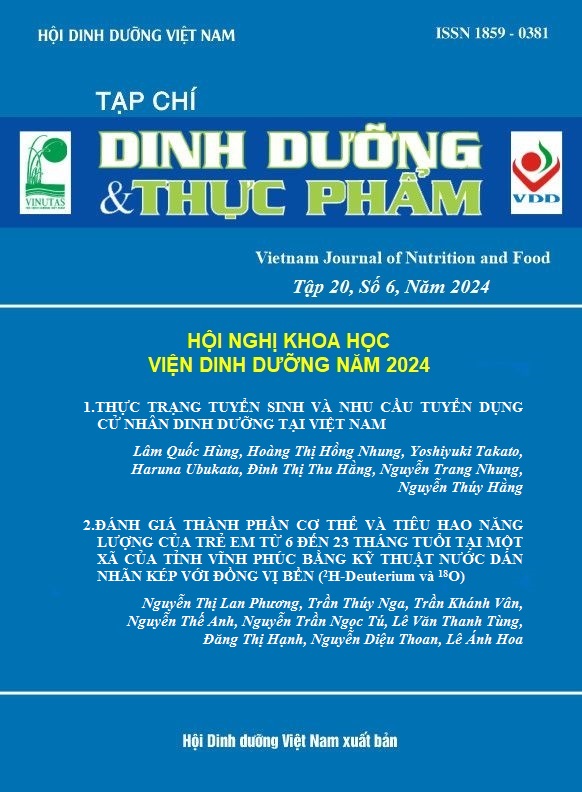NUTRITIONAL STATUS OF PATIENTS WITH SEVERE
AND VERY SEVERE HYPERTRIGLYCERIDEMIA IN THE DEPARTMENT OF ENDOCRINOLOGY - DIABETES, BACH MAI HOSPITAL, 2023-2024
Main Article Content
Abstract
Aims: To assess their nutritional status, food consumption frequency, and 24-hour dietary recall in patients with severe and very severe hypertriglyceridemia at the Department of Diabetes Endocrinology, Bach Mai Hospital.
Methods: A cross-sectional study of 63 patients with serum triglyceride concentration of 5.6 mmol/l or higher from February 2023 to July 2024.
Results: The participants were male (69.1%), under 60 years old (85.7%), and had diabetes (55.6%). The mean serum triglyceride concentration was 29.4 mmol/l, most of the patients had increased triglycerides ≥ 11.3 mmol/l (95.2%). 55.5% of the patients were overweight and obese, the group with TG ≥ 11.3mmol was more overweight and obese than the group with TG< 11.3mmol/l (p>0.05). The majority of the patients had central obesity (95.2% had a high waist-to-hip ratio). The frequency of weekly and daily consumption of alcohol, sweets, fatty meat, animal organs, and processed foods was quite high. The serum TG concentration of these patients also tended to be higher than those who ate less. The ratio of dietary lipid intake was high, participants with higher TG tended to eat more fat. Dietary fiber was low.
Conclusion: Overweight and obesity and the frequency of weekly and daily consumption of alcohol, sweets, fatty meat, animal organs, and processed foods were quite high in people with severe and very severe hypertriglyceridemia.
Keywords
Nutritional status, overweight, obesity, severe hypertriglyceridemia, very severe hypertriglyceridemia, dietary recall.
Article Details
References
2. Mach F, Baigent C, Catapano AL, et al. 2019 ESC/EAS Guidelines for the management of dyslipidaemias: lipid modification to reduce cardiovascular risk: The Task Force for the management of dyslipidaemias of the European Society of Cardiology (ESC) and European Atherosclerosis Society (EAS). Eur Heart J. 2020;41(1):111–188.
3. Virani SS, Morris PB, Agarwala A, et al. 2021 ACC Expert Consensus Decision Pathway on the Management of ASCVD Risk Reduction in Patients With Persistent Hypertriglyceridemia: A Report of the American College of Cardiology Solution Set Oversight Committee. J Am Coll Cardiol. 2021;78(9):960–993.
4. Viện Dinh dưỡng. Nhu cầu dinh dưỡng khuyến nghị cho người Việt Nam. Nxb Y học, Hà Nội, 2016
5. Berglund L, Brunzell JD, Goldberg AC, et al.. Evaluation and treatment of hypertriglyceridemia: an Endocrine Society clinical practice guideline. J Clin Endocrinol Metab. 2012;97(9):2969–2989.
6. Christian JB, Bourgeois N, Snipes R, et al. Prevalence of severe (500 to 2,000 mg/dl) hypertriglyceridemia in United States adults. Am J Cardiol. 2011;107(6):891–897.
7. Pacific WHORO. The Asia-Pacific perspective : redefining obesity and its treatment, Sydney : Health Communications Australia. 2000
8. Medeiros and Wildman R.E.C. (2018), Advanced Human Nutrition, Jones & Bartlett Learning.
9. Viện Dinh dưỡng (2017), Bảng thành phần thực phẩm Việt Nam, nhà xuất bản y học.
10. Bays HE, Toth PP, Kris-Etherton PM, Abate N, Aronne LJ, Brown WV, Gonzalez-Campoy JM, Jones SR, Kumar R, La Forge R, Samuel VT. Obesity, adiposity, and dyslipidemia: a consensus statement from the National Lipid Association. J Clin Lipidol. 2013 Jul-Aug;7(4):304-83.
11. Bảy N.Q. and Lưu P.T. (2020). Đặc điểm và kết quả điều trị tăng Triglyceride máu nặng tại Khoa Nội tiết, Bệnh viện Bạch Mai. Tạp Chí Tim Mạch Học Việt Nam, (91+92), 85–92.
12. Nguyễn VH, & Nguyễn, KDV. Nghiên cứu đặc điểm lâm sàng, cận lâm sàng ở bệnh nhân tăng triglyceride máu cao. Vietnam Journal of Diabetes and Endocrinology. 2023; (54): 69-75.
13.Chait A, den Hartigh LJ. Adipose Tissue Distribution, Inflammation and Its Metabolic Consequences, Including Diabetes and Cardiovascular Disease. Front Cardiovasc Med. 2020;7:22.
14.Skulas-Ray AC, Wilson PWF, Harris WS, et al. Omega-3 Fatty Acids for the Management of Hypertriglyceridemia: A Science Advisory From the American Heart Association. Circulation. 2019;140(12):e673–e691.
15. Han Y, Jang K, Kim U, et al. The Possible Effect of Dietary Fiber Intake on the Metabolic Patterns of Dyslipidemia Subjects: Cross-Sectional Research Using Nontargeted Metabolomics. J Nutr. 2023, 153(9):2552–2560.
Similar Articles
- Tan Thanh VO, Thi My Linh NGUYEN, Thi Hien PHAM, Nguyen Ha Phuong LE, Thi Phuong Thao LE, Thi Thu Suong TRAN, EFFECT OF ADDED RED FLESH DRAGON FRUIT PULP (Hylocereus polyrhizus) ON THE QUALITY OF GLUTINOUS RICE WINE , Vietnam Journal of Nutrition & Food: Vol. 21 No. 3 (2025)
You may also start an advanced similarity search for this article.


